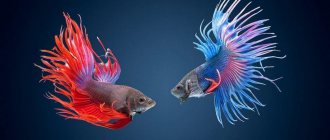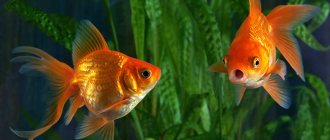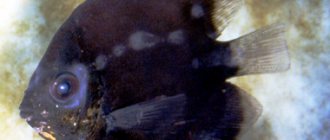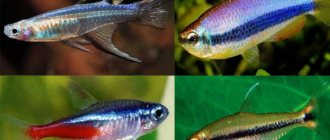Guppy
Guppy diseases usually appear unexpectedly and can lead to the death of the fish. The sources of diseases are already infected other inhabitants of the aquarium, infected decorations, and algae. Dirty water helps pathogenic microorganisms multiply. Fish can become infected from various infections, so they need to be treated promptly.
Rashes and plaque are a reason to sound the alarm
White plaque usually indicates improper functioning of the body. Moreover, this formation should not be confused with clouding of the guppy’s body, which is a signal that the water is of poor quality; it is not always a symptom of the disease.
Alkalosis
During alkalosis, the scales darken, the fish rush around the aquarium, and mucus is noticeable on the body. Occurs in guppies accustomed to water with high acidity. You can get rid of this trouble by bringing the pH to the required level. pH buffers are sold in specialized stores; they will help change the indicators. The body tone may be dull due to inflammation of the gastrointestinal tract. A lot of mucus with blood appears in the stool, and the fish refuses to eat. The guppies are not fed for 5-19 days, then they are given a varied menu.
Saprolegniosis
Saprolegniosis is a disease that appears as a result of prolonged exposure to cool water, poor nutrition, injury, stress, and high acidity. The first sign of the disease is that a coating resembling moss and white “hyphae” appear on the guppies. If they increase, they intertwine with each other, forming a lump similar to cotton wool. It spreads throughout the body. Over time, internal organs become infected. Treatment is carried out in a septic tank, for this purpose the agent bicillin-5 is used. For the dosage of bicilin, see the instructions for use of the drug.
04:24
Saprolegniosis - Symptoms and treatment
03:48
Dermatomycosis, or saprolegniosis - when first detected, the carrier went on a trip!
Gyrodactylosis
A disease when a blue-white coating appears on the guppies. The fins are pressed together, the infected fish itches on the decorations, weakness is noted, the eyes are black or cloudy. Fish swims on the surface of the water. Over time, the fin rays are destroyed and abscesses form on the body. An affected pet may die from lack of air or starvation. Copper sulfate, which is added to the aquarium (20 mg per 12 liters of water), will help treat the disease.
Trichodinosis
Worm disease. The body of a guppy infected with trichodinosis contains parasites of the trichodinid group. They occur due to poor aeration, incorrect acid balance of water or poor quality feeding. At the initial stage, the external sign of fish infection is invisible. She just rubs against the decorations and constantly floats near the filter bubbles.
Later, mucus and gray spots form on the fish’s body. Mucus is noticeable on the gills, the pet loses appetite, and breathing quickens. The fish are transplanted into a quarantine aquarium, in which the temperature is gradually increased to 29°C. Treatment is carried out with salt in a ratio of 25 g per 12 liters of water. Medicines that contain malachite green oxalate will help cure guppies. The acidity level in the tank needs to be restored. It is also necessary to change the diet.
Having seen the external symptoms of the disease, treatment begins by transplanting the infected guppies into a separate aquarium. In the initial stages, the disease in pets can be cured.
Birth of fry
A pregnant female guppy looks different from other fish. Her belly is greatly enlarged and the dark spot near the anal fin is enlarged. The behavior of the fish also suggests that it will soon give birth: it becomes restless, tries to retire, hide in the thickets of plants. Having noticed such features, the aquarist must take measures to preserve future offspring. First of all, you need to move the female to a separate aquarium. This should be done in advance so that the guppy adapts to new conditions. At the same time, premature birth must not be allowed, otherwise the premature fry will die.
Attention! If the right moment for hatching is missed, allow the fish to breed in a community aquarium. After birth, the fry must be carefully caught with a plastic glass and released into a prepared tank.
Diseases of tails and fins
Many people love guppies for their gorgeous bright fins and tail. Moreover, these parts of the body are most susceptible to the climate in the aquarium and are often susceptible to various diseases. Even minor fin defects can be a symptom of the disease:
Fin Compression
Appears due to a lack of required microelements in the body. When sick, the fins become flattened. Sick guppies need to diversify their menu by adding live food. Salt is added daily in a ratio of 15 g per 15 liters. Water needs to be renewed every day to 35-45% of the volume.
Red scab
If the body is very red, there are red spots on the tail and fins, stripes, fins and tail are split - then this is red scab, which is caused by tetrahymena. At the first symptoms of red scab, treatment should begin by transferring the guppies to another tank. The infected areas are cut off with a sterile blade. Afterwards, the fish are placed in a weak saline solution.
Fin rot
Appears due to improper maintenance and infection. Dark spots form on the fins, turning into ulcers with the release of pus. If fin rot is not treated, the guppy will die. Affected fish are treated with antibiotics. An excellent effect is observed after using salt baths, where the fish are kept for 12-17 minutes.
Fin separation
If the tail turns black and the fins begin to split, then the guppy does not have enough vitamin D. For 1 liter of water in the aquarium, you need to add 1 drop of iodine. Fins sometimes split during fights with other fish species. Wrongly chosen neighbors need to be seated.
Content complexity
A great fish for beginners and pros.
Small, active, beautiful, very easy to reproduce, undemanding in maintenance and feeding, it seems that the list can go on forever.
However, we would warn novice aquarists against purchasing bright, selective forms. How to understand that the form is selective? If all the fish in the aquarium are strictly the same color, and the males have long and uniform fins, then these are demanding species.
If the males are all different, like the females, the coloration is a riot of colors and colors, then these are the fish that the average aquarist needs.
The fact is that as a result of crossing, they become very beautiful, but also very capricious, losing their advantages.
Hybrid forms already have weak immunity and are very demanding in terms of maintenance. So if you just decide to try your hand at aquarium keeping, buy the simplest but colorful goops.
They will delight you no less than the selection forms, but they will live much longer and there will be fewer problems.
And for the pros there will be selection forms - they need to be carefully sorted, bred and cared for even more carefully.
Strange behavior, what causes it
The strange behavior of guppies is almost always caused by various diseases. If the fish swims on its side, this is a cause for concern, since this is a symptom of a dangerous disease - glucose disease. Other signs include swelling of the eye or bulging eyes appearing on only one side. The cause of the disease is parasites that multiply quickly and affect the liver, stomach, eyes, and gills. Glugosis is an incurable disease and all guppies die. If the diagnosis is confirmed, all contents of the aquarium are destroyed and the tank is disinfected.
To avoid infection of all fish, new individuals need to be kept in quarantine and only after making sure that the pet is not sick, it is transplanted into a common container.
If a guppy swims with its belly up, there can be many reasons, here are the most common:
- Helminthic infestations.
- Viral or infectious diseases.
- General weakness.
- Oncological or fungal diseases.
- Severe gas formation in the intestines.
- Swim bladder diseases.
- Poor nutrition.
The cause is usually considered to be an inflammatory process in the bladder - this is a contagious disease caused by pathogenic microorganisms. Infection occurs due to poor quality food or water.
If treatment of the disease is started at the first stage, the prognosis is positive. During treatment, the fish should be left without food, this will stop the inflammation.
The lifespan of the fish also influences behavior. Determining the age of a guppy is difficult, but if you are careful, you can see the difference. Young fish have a simple body shape. Growing up pets have a more convex belly, a slight arch on the back, which increases with aging. Guppies up to six months have a fiery disposition and although they have color, the tail is still at the development stage. Adult fish are calmer, after 1 year the color is at its peak.
Aquarium website
Friends, greetings!
Read also: Wi-Fi router does not distribute Wi-Fi
I'm having some bad luck with the guppies. A female guppy died tonight, having spawned as fry just two weeks ago. Until yesterday everything was fine with her. In the evening I noticed that she was behaving strangely: she couldn’t float to the top, she floated near the bottom, always fell on her tail, standing almost vertically with her head up, twitched convulsively, sometimes lay down on the bottom and even turned her belly up. And most importantly, her eyes became completely black, and she herself turned pale and became more transparent. I even recorded a video of her convulsions, a few hours before her death, take a look...
According to the recommendations I read on the Internet, I put her in a bowl of salt water for a couple of hours. She seemed to come to her senses there, began to swim normally, and her eyes brightened. After a transition bath with mixed water (from the aquarium plus salt water 50/50), I returned her to the general aquarium before going to bed. She swam there normally, although mostly on top. And in the morning I found her corpse at the bottom. And all the sides of the dead guppy were covered in small burst vessels, as if hemorrhaging. These are such sad things.
Judging by the symptoms (black eyes, behavior, hemorrhages), it seems to me that she had fish tuberculosis. Based on the video of the deceased fish, can someone please tell me if I’m right or wrong? Should I be afraid of infecting other fish? ———- About my farm:
Guppy twisted
Improper care causes various diseases in guppies. In some cases, it is difficult to accurately determine the cause of a certain pathology.
There are several reasons for spinal curvature:
- The spine was bent to the side. Curvature begins due to the dense population of the aquarium or very hard water. In fry, it is sometimes bent due to birth injuries.
- The spine is curved downwards. This happens due to overeating, which increases pressure on the back. For a sick guppy, the amount of food is reduced. If a fish swims in a common tank, you need to control it so that it does not take food from the other inhabitants.
To prevent the guppy from having a crooked spine, you need to control the diet, where you need to add live food. Moreover, the fish should not be overfed. For the fry, a lot of algae is planted in the aquarium to promote their physical development.
Compatibility
A very peaceful fish that does not cause any trouble to its neighbors. But she can be offended, especially by large and predatory fish, which perceive the guppies only as food.
So you shouldn’t keep fish like swordmouth, giant gourami, pangasius or shark balu.
Also, you should not keep with fish that can tear off the fins of males - Sumatran barb, Denison barb, fire barb, some gourami, for example kissing, thorns.
They get along best with peaceful and small fish: - rasboras, cardinals, congos, neons, cherry barbs, speckled catfish, cockroaches.
Most people who keep this fish do so because they like the bright colors of the males. If you are keeping them just for their appearance, we recommend that you only keep males.
If you want to keep them with shrimp, the guppies themselves will not harm any type of shrimp, not even cherries. However, some large species of shrimp can prey on fish. Not to mention crayfish, for which guppies will simply be food.
Breeding problems
Guppies easily breed in an aquarium, but in some cases, owners note problems in breeding fish. Main reasons:
- Hermatophrodism - it is difficult to detect the disease during visual examination, since female guppies have male genital organs at the same time as female ones. The causes and treatments are not yet clear.
- Infertility is a disease when females are unable to give birth. The color of the guppies loses its saturation, the fish become faded. The causes of the disease are very powerful, bright or prolonged lighting. This disease has no cure.
Problems of juvenile development
The first symptoms that indicate poor health in guppy fry are lethargic behavior and loss of appetite. The fry are always at the bottom of the aquarium or swim near the surface of the aquarium. Problems arise due to poor water quality, irregular cleaning and significant reservoir population.
Stages of growth of guppy fry from birth to adulthood.
The birth of fry with a deformed body or underdeveloped fish with yolk sacs is a sign of improper keeping of the female in the aquarium.
Timely diagnosis of the disease and its correct treatment is an important stage. Sick guppy fry need to be transplanted and the nursery should be disinfected. This will save the rest of the brood from death.
Adviсe
- Before you buy new fish, find out what species they are, their environment, and whether they are compatible with guppies.
- A spare aquarium is required for quarantine of new fish, treatment and spawning.
- If you notice something strange in the behavior and appearance of fish in a pet store, refuse to purchase.
- If it is necessary to improve the conditions of water inhabitants, do it gradually. Any sudden changes in the aquatic environment are a source of stress for pets.
- Fish are more comfortable in a rectangular tank rather than a round one.
Advice and treatment methods vary greatly from one source to another. Sometimes sellers in pet stores give harmful recommendations. Consult with experienced aquarists and veterinarians and check the information carefully.
Other diseases
The inhabitants of aquariums are often infected with various infections and parasites, since their owners do not always follow the rules of maintenance. The health of the guppies is affected by the way they feed.
Common guppy diseases:
Spironculosis
The cause of spironculosis or nexamitosis is flagellate parasites, which develop in the gallbladder and stomach, forming cysts. The infected fish loses weight and hides from others. The guppy's tail collapses, the gills turn red, and mucus appears in the feces. At an advanced stage, wounds and ulcers form on the body. At the initial stages of disease development, the water temperature in the aquarium is increased to 32°C. If there are no positive changes, then medications are used.
Dropsy
The cause of dropsy is a virus or a change in water parameters. Fish also get sick due to overeating, incorrect menu, and irregular cleaning of the tank. During dropsy, the guppy's belly swells, its scales fall off, and its eyes bulge. Pets lose activity and are often at the bottom of the aquarium. Infected fish are treated with antibiotics. It is necessary to periodically replace the water and dilute the food with various products.
Columnaria
Appears due to the Flexibacter parasite. It appears due to the heavy population of the aquarium and its irregular cleaning. In guppies with this disease, their fins become fused and their activity decreases. The body is covered with mucous spots, which increase in size. Sometimes ulcers appear. Pets are treated with antibacterial drugs.
Semolina
Ichthyophthyriosis is caused by the bacterium Ichthyophthirvus. This is a dangerous disease for all fish in the aquarium. It is expressed by a small rash resembling semolina and constant itching. Infected guppies rub against the decor in the aquarium. Over time, ulcers form on the body. Ichthyophthyriosis can be cured with saline solution. Biomycin is used among medicinal drugs.
Plistophorosis
Guppies can suffer from plystophorosis. The rare disease is hereditary. Exact data on the reasons for the appearance have not yet been identified. With plystophorosis, the guppy swims vertically. The fish's activity decreases, its color fades and its appetite worsens. The disease is incurable. If signs of this disease are noticed, the guppies should be immediately removed from the general aquarium, and the soil and algae should be disinfected.
Why do fish start to die?
Newbie mistakes lead to the death of fish. The most common ones are listed below.
Water pollution
Guppies die from contamination in the aquarium, which causes disease, poisoning and lack of oxygen. The liquid must be free of impurities and dechlorinated.
Nitrogen poisoning
When poisoned by nitrogen compounds, the fish's eyes bulge and it shows signs of oxygen starvation. Increase aeration and replace up to 40% of the liquid. Find out how much the concentration of nitrogen compounds in the water is and neutralize the excess using conditioners.
Water temperature
If guppies are kept at inappropriate temperatures (22-28 degrees), they are susceptible to disease. A sudden change in temperature leads to temperature shock and death.
Incorrect launch of fish
Neglecting quarantine when introducing a new fish can lead to the fish dying one by one. The new fish should be observed in a separate container for at least 3-4 weeks, and only if there are no diseases can it be placed in a common aquarium. It is also necessary to gradually adapt newly acquired fish to the conditions of a particular aquarium. Do not release the fish from the bag into the aquarium immediately; add new water little by little every 15–20 minutes.
Fish diseases
Diseases are a common cause of death. Observe the behavior and appearance of the fish, do not delay treatment if you suspect a disease.
Water quality
The quality of the water environment is declining due to:
- Irregular or incomplete aquarium maintenance. Proper care involves siphoning the soil, replacing 25% of the total volume of liquid with clean liquid, and washing the decorations and filter components.
- Overfeeding Excess feed falls to the bottom, polluting the water. Feed your pets small portions and fast them once a week.
- Overpopulation. In a densely populated aquarium, the liquid becomes contaminated faster.
- Lack of equipment. The liquid needs constant filtration and aeration. An aquarium without equipment requires frequent water changes.
Prevention
If the aquarium is inhabited by several individuals or large schools, sick fish must be transplanted from healthy ones so that the former cannot infect them. There are no universal ways to cure diseases, but there are preventive measures. Every person who decides to keep aquarium fish must know them.
Steps to take when treating infected guppies:
- For a sick pet, you need to choose a separate aquarium, where it is convenient to treat it with medications.
- For the depositor, you can use a bottle or other glass container with a volume of two liters. Fill the container with water, which must be taken from a common reservoir and mixed with fresh water.
- The water needs to be renewed daily. Moreover, the aeration device does not need to be used.
- Treat the affected individual in a saline solution. 5 liters of water require 5 grams of salt. You can add 5 drops of iodine. When renewing the water in the sedimentation tank, the concentration of the required substances must be gradually restored.
- A sick guppy should be given live food. This will allow the fish to heal faster.
- Since there is little water in the fish tank, leftover food must be removed immediately to avoid contamination.
These measures will prevent the spread of the disease in a common reservoir and will help in the treatment of many diseases. For complex ailments, guppies need to be treated with medications that are sold in veterinary stores.
In the right conditions, guppies feel great, look bright and reproduce actively.
Guppies are loved by many aquarists for their attractive appearance and ease of maintenance. If you want to populate the aquarium with brightly colored specimens, you need to take into account that they are also susceptible to diseases.
If new species are added to the tank, you need to make sure they are healthy. When purchasing fish, you need to carefully examine them: new neighbors should not be dull in color, emaciated or dejected. If the guppy swims on its side or is on the bottom, you do not need to buy this fish.
But an attractive appearance does not always indicate that a guppy is absolutely healthy. There are diseases that appear externally only after a certain time. To protect yourself from unpleasant consequences, you need to buy fish from reliable stores where they are kept under normal conditions.
Other causes of death
Other reasons that cause guppies to die one after another may include heavily contaminated filter media. Bacteria necessary for the biological balance of substances in water multiply on the filter sponge, the violation of which leads to illness or death. Therefore, replacing or cleaning the filter will help keep your fish healthy.
Overfeeding is one of the most common causes of death of aquarium fish.
Often the cause of the disease is too frequent feeding - excess feed begins to decompose and release harmful substances. The water becomes cloudy, its performance deteriorates, the microflora is disrupted - all this leads to the fact that the fish die.
Also, fish can die due to incompatibility with other inhabitants of the aquarium. Guppies are peaceful fish that do not cause any disturbance to their neighbors, but for predatory species or fish much larger than guppies in size, they can become food or will always remain hungry.
Plistophorosis
Plistophora is one of the most dangerous diseases of aquarium guppy fish, which is transmitted from mother to fry. Recognizing the disease is quite simple: the fish become pale and stop eating, which leads to great exhaustion. The body position of the fish changes: the tail goes down, and the body is at an angle of 45-60 ° C, while the fish make jerking movements.
The parasite lives in the muscle tissue of fish, so the body of the infected fish becomes deformed and movements become spasmodic.
In case of fish disease with plistophora blight, all fish should be immediately destroyed , the soil should be boiled, and plants and equipment should be thoroughly disinfected.
Nitrogen poisoning
If you notice that fish in your aquarium have begun to die, one of the possible reasons is poisoning with nitrogen compounds. During the life of aquarium fish, a large amount of organic matter accumulates in the water - nitrates, nitrites, ammonia.
Without exception, all nitrogen compounds are very toxic and poisonous to the inhabitants of the aquarium. Ammonia is especially dangerous. Its excess in the aquatic environment can cause mass death of the entire aquarium population.
Breakdown of filtration systems, overcrowding in the aquarium, poor aeration, overfeeding are factors that contribute to an increase in nitrogen in the aquatic environment.
You can determine excess nitrogen compounds in an aquarium by the state of the water, namely by smell and color. If the aquatic environment is cloudy, or an unpleasant putrid odor is coming from the aquarium, this means that measures need to be taken to normalize the condition of the aquatic environment. Even if the water is visually clean, but there is a smell, this means that the ammonia process has started.
External filter for an aquarium To normalize water parameters and eliminate ammonia compounds, replace ¼ of the water in the aquarium and increase aeration. You only need to add water that has been standing for 24 hours.
Nitrogen compounds appear in water as a result of the breakdown of waste products of its inhabitants, due to poor purification. Nitrites and nitrates are especially toxic. An increase in their number is accompanied by the appearance of rotten odors, and the aquarium becomes cloudy. Bacteria that process waste products into the nitrogenous compounds described above settle in filter media and soil.
When do the chicks hatch?
The female incubates the eggs for about 3 weeks and to ensure that the future chicks develop correctly, she constantly turns the eggs, warming them evenly on all sides. It leaves the clutch only to satisfy hunger and thirst, as well as to empty the intestines. During this short time, the eggs do not have time to cool.
However, it also happens that the female abandons the clutch. If you want to breed parrots, then your task is to warm the eggs, place them in an incubator.
The chicks hatch in the order in which the eggs are laid. The female feeds them with crop milk and warms them under her wings. The male is located not far from the nest, he can bring food to the female, and sometimes he can incubate eggs when she has been away for a long time. The process of feeding the chicks lasts from 1 to 2 months until they leave the nest. At this time, the nest should be removed so that the couple does not want to reproduce again. Now the female needs rest, after laying she needs to recover.











